The chronic sarcoidosis therapeutics market is projected to rise from USD 292.9 million in 2025 to USD 861.8 million in 2035, at a CAGR of 11.4%. Demand-side dynamics highlight how prevalence rates, clinical practice patterns, patient access, and therapeutic innovation shape the adoption of treatments. Sarcoidosis is a multi-system inflammatory disorder with variable progression, and the chronic form often requires long-term pharmacological management. Increasing recognition of sarcoidosis as a chronic illness rather than an acute, self-limiting condition is raising demand for therapies that provide sustained symptom control and prevent organ damage.
Hospitals and specialty clinics form the core demand centers, where pulmonologists, rheumatologists, and immunologists prescribe corticosteroids, immunosuppressants, and biologics. Patient demand is amplified by rising diagnostic accuracy, as imaging and biomarker-based testing detect sarcoidosis earlier and with greater precision. This shift increases the eligible treatment population, expanding the base for long-term therapeutics. Patients with pulmonary sarcoidosis represent the largest share of demand, though cardiac, ocular, and dermatological manifestations also generate steady uptake across regional healthcare systems.
Demand growth is reinforced by unmet clinical needs. Corticosteroids remain the first-line treatment but are associated with long-term toxicity, prompting physicians to adopt steroid-sparing regimens using methotrexate, azathioprine, or leflunomide. Increasing reliance on biologics such as anti-TNF agents or pipeline monoclonal antibodies reflects patient and physician demand for safer, targeted, and more effective options. Patient advocacy groups and rare disease initiatives have been instrumental in amplifying demand by raising awareness and pushing for greater access to innovative therapies.
Regional variations in demand are significant. North America represents the largest market, supported by strong awareness, reimbursement coverage, and access to advanced biologics. Europe follows closely, with demand shaped by national healthcare systems and increasing inclusion of sarcoidosis under rare disease policies. Asia Pacific demonstrates rising demand potential as diagnostic infrastructure improves and patient registries expand, though affordability and limited physician awareness remain barriers. Latin America and Africa represent emerging demand pools where limited access to advanced biologics constrains growth but rising diagnosis rates indicate latent potential.
Patient-centric healthcare trends are reshaping demand. Growing emphasis on quality of life, long-term monitoring, and multidisciplinary care creates greater need for therapies that provide symptom relief with fewer side effects. Telemedicine platforms and digital patient support programs are expanding access in regions with limited specialty care availability, indirectly stimulating therapeutic demand.
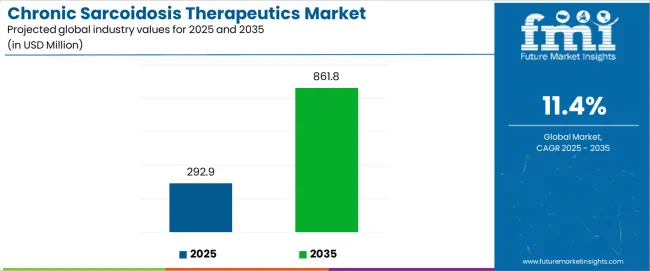
Between 2025 and 2030, the Chronic Sarcoidosis Therapeutics market is projected to expand from USD 292.9 million to USD 484.7 million, resulting in a value increase of USD 191.8 million, which represents 33.7% of the total forecast growth for the decade. This phase of growth will be shaped by increasing diagnosis rates of chronic sarcoidosis, expanding healthcare access in emerging markets, and growing awareness among healthcare professionals about advanced treatment options. Pharmaceutical companies are investing in research and development to address the unmet medical needs in chronic sarcoidosis management.
From 2030 to 2035, the chronic sarcoidosis therapeutics market is forecast to grow from USD 484.7 million to USD 861.8 million, adding another USD 377.1 million, which constitutes 66.3% of the ten-year expansion. This period is expected to be characterized by introduction of novel therapeutic approaches, increased adoption of personalized medicine strategies, and expansion of treatment accessibility in developing regions. The growing understanding of sarcoidosis pathophysiology will drive development of more targeted and effective therapeutic interventions.
| Metric | Value |
|---|---|
| Estimated Value in (2025E) | USD 292.9 million |
| Forecast Value in (2035F) | USD 861.8 million |
| Forecast CAGR (2025 to 2035) | 11.4% |
The autoimmune diseases therapeutics market holds the largest share, contributing about 30-35%, as therapies designed for autoimmune conditions such as corticosteroids, immunosuppressive agents, and biologics are integral in managing chronic sarcoidosis. These therapies help control inflammation and prevent organ damage. The respiratory therapeutics market follows with a contribution of 18-22%, primarily addressing the pulmonary complications of sarcoidosis. Medications aimed at reducing pulmonary fibrosis, improving lung function, and managing inflammation are vital for patients with respiratory involvement. The dermatological therapeutics market contributes around 12-15%, focusing on the treatment of skin manifestations of the disease.
The oncology therapeutics market plays a smaller but important role, accounting for about 8-10%, as immune system modulators, including monoclonal antibodies and immune checkpoint inhibitors, are explored for their potential to treat sarcoidosis due to similarities in immune pathways. The cardiovascular therapeutics market provides roughly 6-8% of the share, as chronic sarcoidosis can involve the heart, leading to arrhythmias, heart failure, or other cardiovascular complications. Drugs aimed at managing heart conditions in sarcoidosis patients help mitigate these risks
Market expansion is being supported by the increasing prevalence of chronic sarcoidosis globally and the corresponding need for effective long-term treatment approaches. The condition affects multiple organ systems and requires comprehensive management strategies that combine anti-inflammatory medications, immunosuppressive therapies, and supportive care measures. Growing understanding of disease mechanisms is enabling development of more targeted therapeutic interventions that address specific pathways involved in chronic inflammation and granuloma formation.
The expanding awareness of chronic sarcoidosis among healthcare professionals and patients is driving demand for specialized diagnostic services and treatment programs. Medical education initiatives and professional guidelines are improving recognition of the condition's diverse clinical presentations and the importance of early intervention. Research advances in genomics and biomarker identification are facilitating development of personalized treatment approaches that optimize therapeutic outcomes while minimizing adverse effects.
The chronic sarcoidosis therapeutics market is segmented by drug type, route of administration, end user, and region. By drug type, the chronic sarcoidosis therapeutics market is divided into corticosteroids, immunosuppressants, TNF-alpha inhibitors, antimalarials, and others. Based on the route of administration, the market is categorized into oral, injectable, and inhalation. In terms of end user, the market is segmented into hospitals, specialty clinics, ambulatory surgical centers, and homecare settings. Regionally, the market is divided into North America, Europe, East Asia, South Asia & Pacific, Latin America, and the Middle East & Africa.
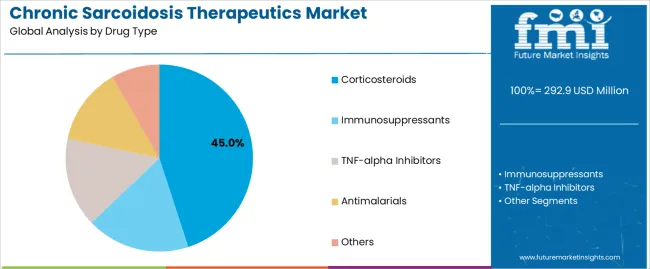
Corticosteroids are projected to account for 45% of the Chronic Sarcoidosis Therapeutics market in 2025. This leading share is supported by their established role as first-line therapy for managing inflammatory manifestations of chronic sarcoidosis. Corticosteroids provide effective anti-inflammatory activity that helps reduce granulomatous inflammation and associated symptoms across multiple organ systems. The segment benefits from extensive clinical experience, well-established dosing protocols, and availability of multiple formulations that allow for individualized treatment approaches.
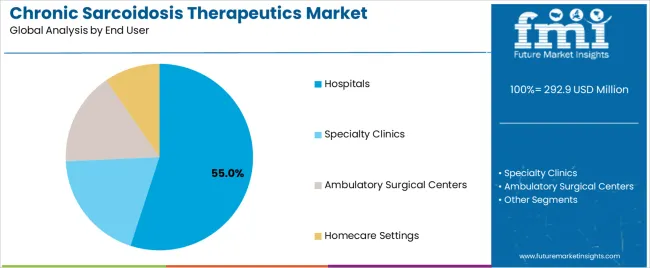
Hospitals are expected to represent 55% of chronic sarcoidosis therapeutics demand in 2025. This dominant share reflects the complex nature of chronic sarcoidosis management and the need for specialized healthcare facilities with multidisciplinary teams. Hospitals provide comprehensive diagnostic capabilities, access to specialized physicians, and ability to manage complex cases that may require combination therapies or treatment of complications. The segment benefits from advanced monitoring capabilities and access to newer therapeutic options that may require specialized administration or close patient monitoring.
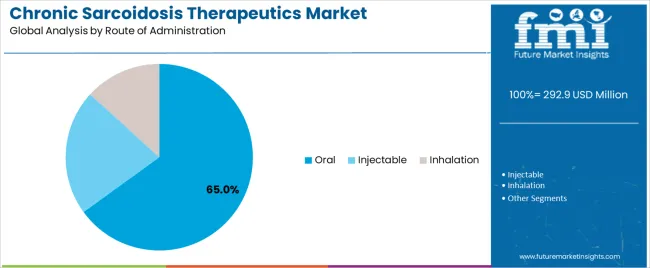
Oral administration is projected to contribute 65% of the chronic sarcoidosis therapeutics market in 2025, representing the preferred route for most chronic sarcoidosis medications. Oral formulations offer convenience for long-term therapy management, improved patient compliance, and ease of dose adjustments based on treatment response and side effect profiles. The segment benefits from patient preference for self-administered medications and the availability of multiple oral therapeutic options, including corticosteroids, immunosuppressants, and antimalarial agents.
The Chronic Sarcoidosis Therapeutics market is advancing steadily due to increasing disease recognition and growing understanding of treatment approaches. The chronic sarcoidosis therapeutics market faces challenges including limited awareness of the condition among some healthcare providers, diagnostic complexities due to variable clinical presentations, and potential side effects associated with long-term immunosuppressive therapy. Research initiatives and clinical trials continue to influence treatment protocol development and market growth patterns.
The growing development of targeted therapeutic approaches is enabling more precise treatment of chronic sarcoidosis based on specific disease manifestations and patient characteristics. Novel medications targeting specific inflammatory pathways and cytokine networks are providing alternative treatment options for patients who do not respond adequately to conventional therapy. These targeted approaches offer potential for improved efficacy while reducing systemic side effects associated with broad-spectrum immunosuppressive medications.
Modern chronic sarcoidosis management is incorporating multidisciplinary care models that combine expertise from pulmonologists, rheumatologists, dermatologists, and other specialists based on organ system involvement. Integration of comprehensive care teams enables coordinated treatment planning and monitoring that addresses the complex, multi-system nature of chronic sarcoidosis. Advanced care coordination also supports patient education and adherence programs that improve treatment outcomes and quality of life.
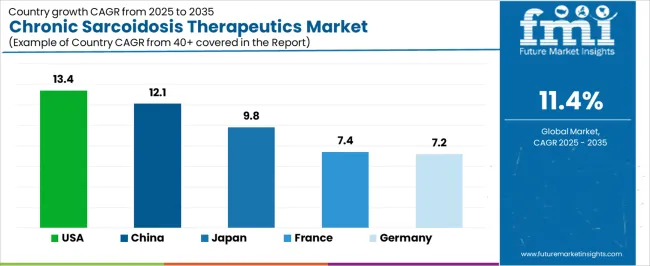
| Country | CAGR (2025-2035) |
|---|---|
| United States | 13.4% |
| Germany | 7.2% |
| France | 7.4% |
| Japan | 9.8% |
| China | 12.1% |
The chronic sarcoidosis therapeutics market is growing rapidly, with China leading at a 12.1% CAGR through 2035, driven by increasing disease recognition, expanding healthcare infrastructure, and growing access to specialized treatment centers. The United States follows at 13.4%, supported by advanced research capabilities, comprehensive healthcare coverage, and established clinical networks. Japan grows steadily at 9.8%, benefiting from aging population demographics and advanced healthcare technologies. France and Germany record similar growth at 7.4% and 7.2% respectively, emphasizing evidence-based treatment protocols and specialized care centers. Developed markets demonstrate strong growth potential in chronic sarcoidosis therapeutics adoption.
Revenue from chronic sarcoidosis therapeutics in the United States is projected to exhibit strong growth with a CAGR of 13.4% through 2035, driven by advanced research capabilities in autoimmune and inflammatory diseases and comprehensive healthcare coverage that supports access to specialized treatments. The country's established network of academic medical centers and specialized sarcoidosis clinics provides comprehensive diagnostic and treatment services that drive market expansion.
Major pharmaceutical companies and research institutions are conducting extensive clinical trials to develop novel therapeutic approaches for chronic sarcoidosis management. Healthcare systems are implementing evidence-based treatment protocols and multidisciplinary care models that improve patient outcomes and drive utilization of advanced therapeutic options. The growing recognition of sarcoidosis as a significant health concern and increased awareness among healthcare providers contribute to improved diagnosis rates and treatment initiation. Insurance coverage expansions and patient advocacy initiatives are facilitating access to specialized care and newer therapeutic agents that address unmet medical needs in chronic sarcoidosis management.
Demand for chronic sarcoidosis therapeutics in Germany is projected to grow at a CAGR of 7.2%, supported by the country's emphasis on evidence-based medicine and systematic approach to chronic disease management. German healthcare systems are implementing comprehensive sarcoidosis management protocols that combine traditional therapeutic approaches with newer targeted medications based on individual patient characteristics and disease manifestations. The country's strong healthcare infrastructure and specialized medical centers provide access to advanced diagnostic capabilities and treatment monitoring that optimize therapeutic outcomes.
Research collaborations between academic institutions and pharmaceutical companies are advancing understanding of sarcoidosis pathophysiology and developing personalized treatment strategies. Healthcare providers are adopting multidisciplinary care models that integrate expertise from multiple specialties to address the complex nature of chronic sarcoidosis. Patient education initiatives and support programs are improving treatment adherence and quality of life outcomes among individuals with chronic sarcoidosis. The integration of advanced diagnostic technologies and biomarker research is enabling more precise treatment selection and monitoring approaches that enhance therapeutic effectiveness while minimizing adverse effects.
In Japan, the chronic sarcoidosis therapeutics market is largely driven by the corticosteroids segment, which accounts for 52% of total treatment revenues in 2025. The high utilization of corticosteroids reflects established clinical practices and proven effectiveness in managing inflammatory manifestations of chronic sarcoidosis. Immunosuppressants follow with a 28% share, primarily used in patients requiring steroid-sparing approaches or those with refractory disease. TNF-alpha inhibitors contribute 15% as emerging therapeutic options for complex cases that do not respond adequately to conventional treatments. Other therapeutic approaches including antimalarials account for the remaining 5% of the chronic sarcoidosis therapeutics market.
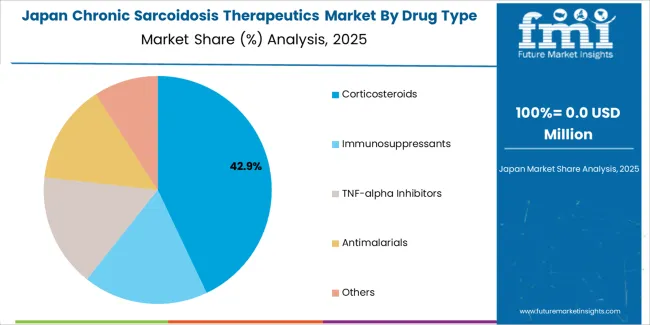
| Drug Type | Market Share (%) |
|---|---|
| Corticosteroids | 52% |
| Immunosuppressants | 28% |
| TNF-alpha Inhibitors | 15% |
| Others | 5% |
The Chronic Sarcoidosis Therapeutics market in Europe is projected to grow from USD 78.5 million in 2025 to USD 145.2 million by 2035, registering a CAGR of 6.3% over the forecast period. Germany is expected to maintain its leadership with 24.2% share in 2025, supported by its advanced healthcare infrastructure and strong research capabilities in autoimmune and inflammatory diseases.
| Country | Corticosteroids Share | Hospitals Share |
|---|---|---|
| Germany | 48% | 58% |
| France | 46% | 56% |
| United Kingdom | 44% | 54% |
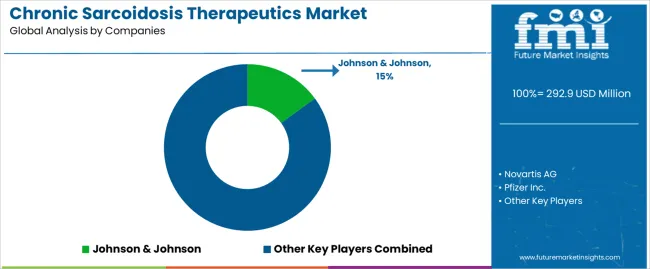
The chronic sarcoidosis therapeutics market is highly competitive, with several industry leaders vying for market share by focusing on innovative treatments for managing the disease. Johnson & Johnson and AbbVie lead with established autoimmune portfolios, positioning their therapies to treat the inflammatory symptoms of sarcoidosis. Their focus on corticosteroid alternatives and immunomodulatory drugs plays a key role in reducing treatment side effects and improving long-term outcomes. Novartis and Roche are also key competitors, focusing on targeted biologic therapies designed to address the underlying immune dysfunction in sarcoidosis, with ongoing clinical trials exploring their potential as disease-modifying treatments.
Pfizer and Merck & Co. continue to advance immunosuppressive and corticosteroid-sparing treatments, offering alternatives that aim to minimize the long-term complications of steroid use. Their efforts are centered on developing biologics that could offer relief from sarcoidosis flare-ups. Bristol-Myers Squibb and Sanofi are exploring innovative therapies targeting specific immune pathways, which could lead to breakthrough treatments for managing chronic sarcoidosis. These companies emphasize improving the quality of life for patients while reducing the treatment burden.
GlaxoSmithKline and Mallinckrodt Pharmaceuticals focus on addressing sarcoidosis co-morbidities and immune modulation. GSK’s broad inflammation management approach offers potential for treating sarcoidosis alongside other autoimmune conditions. Mallinckrodt leverages its expertise in rare disease treatments, with an emphasis on corticosteroid-based therapies and immune modulation for chronic sarcoidosis. Product brochures from these companies showcase their range of immunosuppressants, biologics, and corticosteroid alternatives designed to reduce inflammation and prevent disease progression, positioning them as key players in the evolving therapeutic landscape for chronic sarcoidosis.
| Item | Value |
|---|---|
| Quantitative Units | USD 861.8 million |
| Drug Type | Corticosteroids, immunosuppressants, TNF-alpha inhibitors, antimalarials, and others |
| End User | Hospitals, specialty clinics, ambulatory surgical centers, and homecare settings |
| Route of Administration | Oral, injectable, and inhalation |
| Regions Covered | North America, Europe, East Asia, South Asia & Pacific, Latin America, Middle East & Africa |
| Country Covered | United States, Germany, France, United Kingdom, Japan, China, India |
| Key Companies Profiled | Johnson & Johnson, Novartis AG, Pfizer Inc., AbbVie Inc., Roche Holding AG, Sanofi SA, Bristol-Myers Squibb, Merck & Co., GlaxoSmithKline plc, Mallinckrodt Pharmaceuticals |
The global chronic sarcoidosis therapeutics market is estimated to be valued at USD 292.9 million in 2025.
The market size for the chronic sarcoidosis therapeutics market is projected to reach USD 861.8 million by 2035.
The chronic sarcoidosis therapeutics market is expected to grow at a 11.4% CAGR between 2025 and 2035.
The key product types in chronic sarcoidosis therapeutics market are corticosteroids , immunosuppressants, tnf-alpha inhibitors, antimalarials and others.
In terms of end user, hospitals segment to command 55.0% share in the chronic sarcoidosis therapeutics market in 2025.






Full Research Suite comprises of:
Market outlook & trends analysis
Interviews & case studies
Strategic recommendations
Vendor profiles & capabilities analysis
5-year forecasts
8 regions and 60+ country-level data splits
Market segment data splits
12 months of continuous data updates
DELIVERED AS:
PDF EXCEL ONLINE
Chronic Phase Markers Market Size and Share Forecast Outlook 2025 to 2035
Chronic Venous Occlusions Treatment Market Size and Share Forecast Outlook 2025 to 2035
Chronic Lymphocytic Leukemia Market Size and Share Forecast Outlook 2025 to 2035
Chronic Dryness Repair Market Analysis - Size and Share Forecast Outlook 2025 to 2035
Chronic Skin Redness Care Market Size and Share Forecast Outlook 2025 to 2035
Chronic immune thrombocytopenia treatment Market Size and Share Forecast Outlook 2025 to 2035
Chronic Hepatitis B Virus Testing Market Size and Share Forecast Outlook 2025 to 2035
The Chronic Wound Care Market is segmented by product, wound type and distribution channel from 2025 to 2035
Chronic Disease Management Market Size and Share Forecast Outlook 2025 to 2035
Chronic Brain Damage Treatment: Trends, Growth, and Key Developments
Chronic Pulmonary Hypertension Treatment Market Analysis and Forecast by Drug Type, Route of Administration, Distribution Channel, Region through 2035
Chronic Smell and Flavor Loss Treatment Market – Innovations & Growth 2025 to 2035
Chronic Granulomatous Disease (CGD) Management Market – Size, Share & Trends 2025 to 2035
Chronic Refractory Cough Treatment Market – Growth & Innovations 2025 to 2035
Chronic Pain Market Analysis – Growth, Demand & Forecast 2024 to 2034
Chronic Obstructive Pulmonary Disease (COPD) Market Trends – Growth & Forecast 2023-2033
Chronic Respiratory Diseases Treatment Market
Chronic Lymphocytic Leukemia Therapeutics Market Size and Share Forecast Outlook 2025 to 2035
Late Stage Chronic Kidney Disease Therapeutics Market Size and Share Forecast Outlook 2025 to 2035
Sarcoidosis Therapeutics Market

Thank you!
You will receive an email from our Business Development Manager. Please be sure to check your SPAM/JUNK folder too.
Chat With
MaRIA